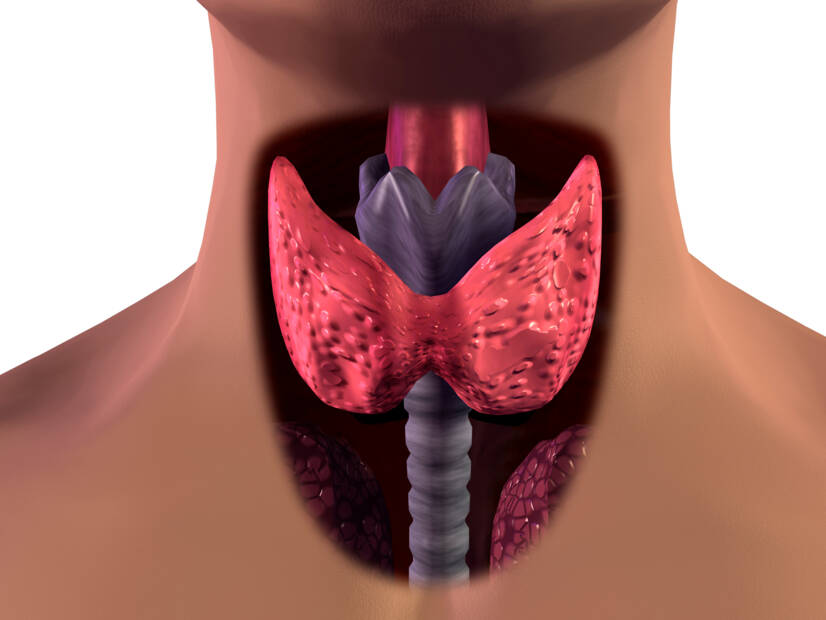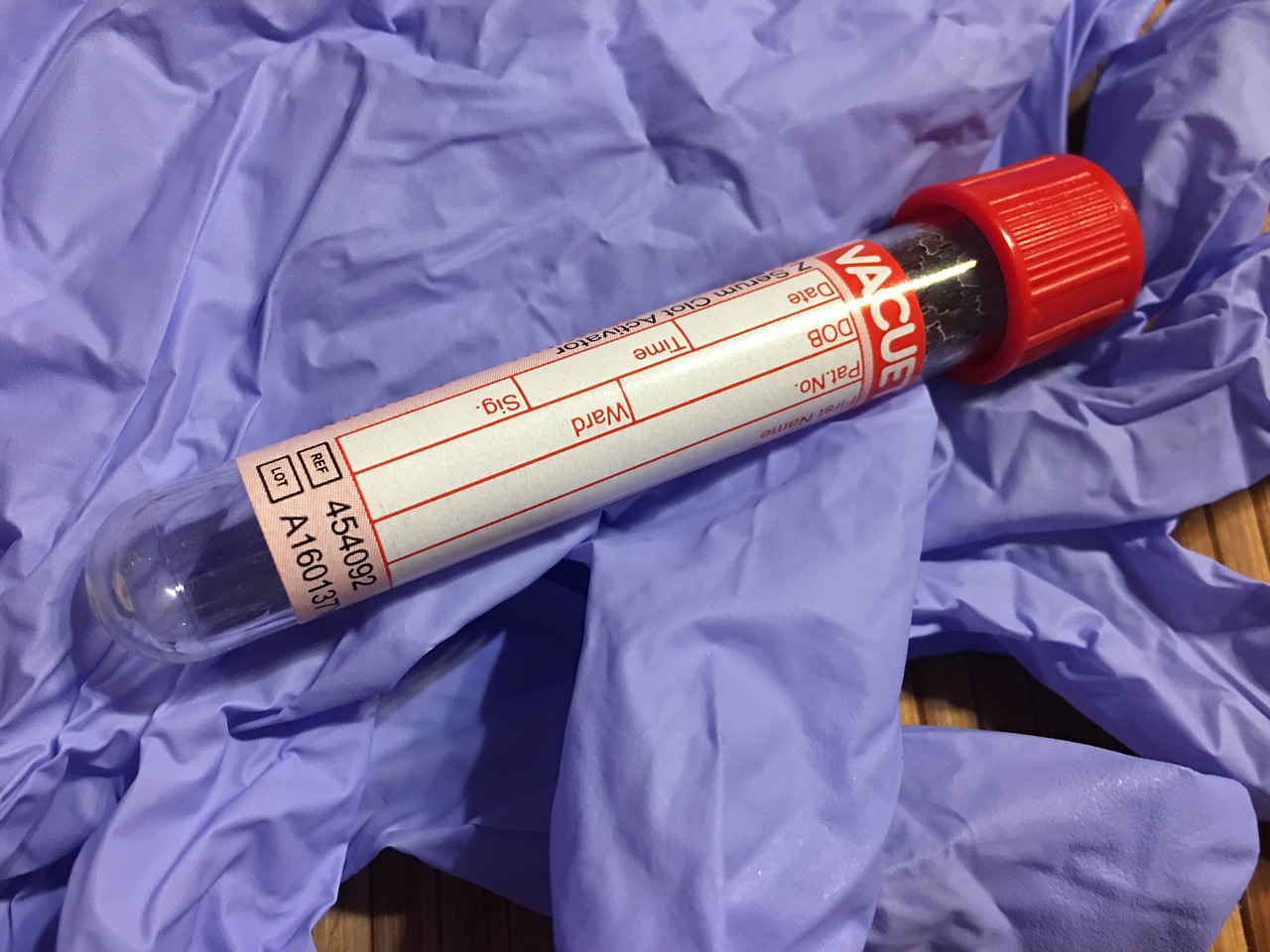- "Hyperthyroidism". www.niddk.nih.gov.
- Devereaux D, Tewelde SZ (May 2014). "Hyperthyroidism and thyrotoxicosis". Emergency Medicine Clinics of North America. 32 (2): 277–292.
- Bahn Chair RS, Burch HB, Cooper DS, Garber JR, Greenlee MC, Klein I, et al. (June 2011). "Hyperthyroidism and other causes of thyrotoxicosis: management guidelines of the American Thyroid Association and American Association of Clinical Endocrinologists". Thyroid. 21 (6): 593–646.
- Kelly DM, Lynch T, Casserly LF (September 2017). "Abdominal tremor in thyrotoxicosis". Neurology. 89 (13): 1424–1425.
- Schraga ED (30 May 2014). "Hyperthyroidism, Thyroid Storm, and Graves Disease".
- NIDDK (13 March 2013). "Hypothyroidism".
- Brent GA (June 2008). "Clinical practice. Graves' disease". The New England Journal of Medicine. 358 (24): 2594–2605.
- Koutras DA (June 1997). "Disturbances of menstruation in thyroid disease". Annals of the New York Academy of Sciences. 816 (1 Adolescent Gy): 280–284.
- Shahid MA, Ashraf MA, Sharma S (January 2021). "Physiology, Thyroid Hormone". StatPearls [Internet]. Treasure Island (FL): StatPearls Publishing.
- "Thyrotoxicosis and Hyperthyroidism". The Lecturio Medical Concept Library.
- "Depression and Psychosis in Neurological Practice.". Bradley's neurology in clinical practice (6th ed.). Philadelphia, PA: Elsevier/Saunders. 2012. pp. 102–103. ISBN 978-1437704341.
- Chan WB, Yeung VT, Chow CC, So WY, Cockram CS (April 1999). "Gynaecomastia as a presenting feature of thyrotoxicosis". Postgraduate Medical Journal. 75 (882): 229–231.
- Trabelsi L, Charfi N, Triki C, Mnif M, Rekik N, Mhiri C, Abid M (June 2006). "[Myasthenia gravis and hyperthyroidism: two cases]". Annales d'Endocrinologie (in French). 67 (3): 265–9.
- "Hyperthyroidism". American Thyroid Association.
- Mehtap C (2010). Differential diagnosis of hyperthyroidism. Nova Science Publishers. pp. xii. ISBN 978-1-61668-242-2.
Hyperthyroidism: Why does it occur and how does it manifest? + Values and treatment

Hyperthyroidism, or the overactive thyroid gland, is relatively common in the human population. It causes a number of unpleasant difficulties. But why?
Most common symptoms
- Frequent urination
- Hoarseness
- Sensitivity to light
- Nausea
- Diarrhoea
- Oily skin
- Sweating
- Excessive Hair Loss: Causes, Treatment
- Strokes on the nails
- The Island
- Concentration disorders
- Menstrual cycle disorders
- Mood disorders
- White patches on the skin
- Tremor
- Cutting the eye
- Muscle weakness
- Fatigue
- Vomiting
- High blood pressure
- Bulging eyes
- Accelerated heart rate
- Increased appetite
- Increased watery eye
Characteristics
Hyperthyroidism is a disease and clinical syndrome caused by an overproduction of thyroid hormones. These are specifically the hormones thyroxine and triiodothyronine.
As a result of this excessive production of hormones, metabolism is accelerated. This brings with it several complications, risks and manifestations.
The disease affects about 2 percent of the population. More women than men.
You are often interested in: What is hyperthyroidism (and what does hypothyroidism mean) and why does it occur? How does it manifest itself and what are its risks? How is dietary treatment treated and needed? How does it relate to pregnancy?
The thyroid gland is an important organ that affects the whole body. Its function is the production of hormones. These in the body affect various organs and metabolism. Disorders of hormone secretion subsequently have a negative effect.
The glandular function may be increased or decreased. However, hyperthyroidism is a sign of excessive production of its hormones.
Hyper = excess, more than normal, excessive activity / production. Hypo = deficiency, less than normal, insufficient activity / production. Hyperthyroidism = excessive activity and production of hormones. Hypothyroidism = insufficient activity and production of hormones.
What are the thyroid gland and its hormones?
The thyroid gland significantly affects the metabolic processes in the body. However, the dysfunction of its function negatively affects not only the metabolism but also other organs, ie the whole human body. The thyroid gland is located under the skin on the front of the neck. The thyroid cartilage urges from the top. Well visible and more pronounced bite in men.
Thyroid cells make hormones. And thyroxine is also referred to as T4, and triiodothyronine, ie T3. Iodine is important for their formation. T4 has four and T3 has three iodine atoms. And along with iodine, selenium is important in the production of the hormone T3. Lack of these elements has a negative effect on glandular function.
Thyroid hormone values are:
T3 = 3.5 - 6.5 pmol / liter
T4 = 12.0 - 22 pmol / liter
and TSH value = 0.5 - 5.0 mIU / liter.
In addition to iodine and selenium, another hormone also affects the activity of the thyroid gland, which actually regulates it. This hormone is produced in the pituitary gland and is called TSH, a thyroid-stimulating hormone or thyroid-stimulating hormone
What is the significance of thyroid hormones?
They are involved in the metabolism of sugars, fats, and also proteins. They affect energy management. Their action is across the whole organism, all organs. They speed up or slow down the heart. A serious disorder can lead to heart failure.
Energy management affects a person's weight. Failure to do so may result in weight loss or weight gain. Similarly, they also affect the value of sugar, cholesterol. Thyroid hormones are also present in the body's own protein production.
During intrauterine development, they are involved in the development of the brain, nerves, but also the muscles and bones of the fetus. Of course, for the rest of life, during childhood, adolescence, or adulthood. Osteoporosis, for example, is also responsible for excess hormones.
Thyroid disorders
Various diseases can affect the function of the thyroid gland and thus the production of hormones. This is either its increased or decreased function. But there are also diseases that do not affect the function and hormonal production remains normal.
Professional designation of thyroid function, which is commonly encountered by the layman:
- reduced function, ie the production of hormones - hypothyroidism
- normal function - euthyroidism
- increased function - hyperthyroidism, but also thyrotoxicosis
For example, normal thyroid function remains in nodules, tumors, or some inflammation of the gland. The term goiter is also well known. Which is actually the enlargement of the gland as such. To a larger extent, the goiter is clearly visible.
The goiter can be caused by a knot, a tumor, inflammation, or even a lack of iodine. However, enlargement may not be present in the disease. Conversely, with reduced function, the gland can also be reduced.
What is hyperthyroidism?
Excessive hormone production affects the metabolism, as mentioned, as well as the whole organism and every organ in the body. The technical term for increased hormone production is hyperthyroidism. It is caused by various diseases. Thyrotoxicosis, as excessive hormone production is otherwise called, is characterized not only by increased secretion of thyroid hormones but also by an increased response of peripheral tissues to these hormones.
The disease takes several forms, and the dysfunction can be a peripheral, central, ectopic, and hCG form. The central form of the disease is relatively rare and is directly related, for example, to pituitary adenoma. In ectopic diseases, it is associated with ovarian tumors and hCG is most often associated with pregnancy.
How the disease progresses and manifests itself depends on its form, but also on the age and health of the patient. Some processes may not be affected by excessive hormone levels enough to be visible to the outside world. However, overall, this syndrome causes an acceleration of metabolic and other processes in the body.
Women over the age of 50, for example, are at risk for people who need to think about thyroid disease

Some risk factors :
- positive family history, ie the occurrence of the disease in the family
- thyroid dysfunction in the past
- thyroid antibodies present
- the presence of some symptoms
- elevated cholesterol
- type I diabetes
- celiac disease
- immune problems
- drugs such as amiodarone or biologic therapy
- irradiation, radiation treatment
- infertility, miscarriage, but also premature birth
Causes
Hyperthyroidism can have several causes. The most common cause is Graves-Basedow disease, especially in young people. Toxic adenoma and toxic goiter predominate in the elderly population. Oxyphilic cell follicular carcinoma is less common.
Overproduction can also be caused by inflammation of the thyroid gland, ie thyroiditis. Central reasons are, for example, pituitary adenoma, which produces TSH. Which in turn stimulates the overproduction of thyroid hormones. Resistance to thyroid hormones is rare.
In some cases, an excess of thyroid hormones can also cause an ovarian or testicular tumor. In the case of pregnancy, hyperthyroidism occurs in women shortly after childbirth, when women may suffer from postpartum thyroiditis. This is only a temporary condition.
It can also be caused by excessive use of tablets containing thyroid hormones. An increased function may also be induced in addition to the treatment of cardiac arrhythmias when amiodarone is used or when iodine-containing products are taken in excess. An example is a contrast agent that is used in X-rays or CT scans.
Summary of the causes of overproduction of thyroid hormones:
- Graves-Basedow disease
- thyroid nodules, the head in the elderly
- nodular or even polynodose goiter, which are multiple nodes of the thyroid gland
- solitary node, ie a separate node
- inflammation, ie thyroiditis
- chronic autoimmune inflammation (Hashimoto's thyroiditis)
- granulomatous thyroiditis
- thyroid tumor
- thyroid adenoma is the most common, but benign, ie benign tumor
- follicular carcinoma
- ovarian tumor, such as teratoma
- testicular tumor
- pituitary adenoma, which is the central cause
- resistance to thyroid hormones
- medication or overdose
- containing thyroid hormones
- amiodarone
- iodine-containing preparations, contrast medium
- hCG overproduction in pregnancy, hCG is the hormone chorionic gonadotropin
- postpartum inflammation, which passes after weeks to months without treatment
Symptoms

Due to the increased production of the hormones thyroxine and triiodothyronine, both general and specific symptoms occur. Acceleration of metabolism is typical, which requires an increased need for energy. Subsequently, weight loss occurs.
A person with hyperthyroidism is therefore poor, he is also characterized by a relentless feeling of hunger, the so-called wolf hunger. Diarrhea is associated with faster digestion. Overall, there is muscle weakness, mild tremors on the hands. Mental disorders include insomnia, fatigue, mood disorders, nervousness.
Heart palpitations are also typical, based on a fast heartbeat or other heart rhythm disorder. Atrial fibrillation is common. There is also high blood pressure. One can breathe faster during exertion. Sweating and hot flushes. Swelling is noticeable on the end parts.
The thyroid gland may enlarge, but this is not a condition for hyperthyroidism. This magnification is called goiter. Some people may experience eye symptoms, including:
- pain behind the eye
- bulging, protruding eyes - exophthalmos
- inability to close the lids completely, causes
- drying of the eye, cornea
- double vision
- burning
- cutting
- tearing
- visual disturbances, for optic nerve oppression
Women may experience menstrual disorders, especially less frequent or no menstruation. Suspicion of hyperthyroidism should also be raised in the case of miscarriage or premature birth. In the case of the male sex, potency disorders may occur.
It also affects the skin, both by white spots on the body and redness on the face. The skin is soft, warm, moist, and quickly lubricating. The person has an accelerated hair growth, the hair is fine, it falls out more, so it is thinner.
The table shows a group of subjective, ie perceived and objective, ie externally visible symptoms
| Subjective symptoms | Objective symptoms |
| palpitations, so-called palpitations, for accelerated heart rate | accelerated pulse, atrial fibrillation on ECG |
| feeling pressure and palpitations in the throat | faster breathing during exertion |
| muscle weakness | heart failure, if thyrotoxicosis persists |
| limb routes | limb routes |
| increased thirst | enlarged thyroid gland is not a condition |
| sweating | sweaty skin |
| hot flushes | warm skin |
| frequent urge to urinate | eye symptoms, exophthalmos, ie protruding eyes |
| eye symptoms | emaciation |
| weight loss | osteoporosis |
| nausea, feeling sick (vomiting) to vomiting | restlessness |
| frequent diarrhea for rapid bowel movements | skin changes, red face |
| menstrual disorders, fertility | fine hair, thinning hair |
| erectile dysfunction in men | |
| fatigue, sleep disorders | |
| anxiety, nervousness, restlessness to irritation |
Diagnostics
The disease can be seen on the basis of the initial symptoms. Unusual heart palpitations, fast heartbeat, or even sweating or tiredness in young people. Hyperthyroidism is suspected even with weight loss and digestive problems. However, these are too general symptoms.

So blood tests are the most reliable. Thyroid hormone levels are measured. The values of the hormones thyroxine - T3 and triiodothyronine - T4 are increased. Subsequently, the TSH level is assessed. When assessing hormonal levels, the evaluation of TSH, T4, and T3 is usually sufficient.
If TSH levels are low, it means that its production is suppressed by high levels of thyroid hormone. Put simply, the adenohypophysis produces less thyroid-stimulating hormone (TSH) when there are high levels of thyroid hormones in the blood.
However, a control TSH blood test may indicate decreased pituitary function and other problems. Therefore, it is better to perform the T4 and T3 test at the same time. Evaluations of specific antibodies are also helpful. Their result can determine, for example, GB disease, ie Graves-Basedow disease.
Auxiliary imaging methods include, for example, CT, scintigraphy, X-ray examination of the thyroid gland, and also the chest. The main reason for finding a doctor is, rightly, the data in the anamnesis. Such as heart palpitations and other manifestations of the disease. The general practitioner and the endocrinologist cooperate in determining the diagnosis.
Course
The disease begins to manifest itself gradually over time. In particular, there is an acceleration of metabolism, and thus the whole organism. The demand for energy is therefore also higher. One gets poor and, of course, feels so-called wolf hunger. Paradoxically, in some cases, it can gain weight due to excessive food intake.

General fatigue, but also muscle weakness, associated mental difficulties, such as anxiety. The person is irritated, nervous . May have sleep disorders. These difficulties worsen the mental condition.
An increase in heart rate will cause the heart to pound. Severe cardiac arrhythmias, as well as heart failure, can occur with an untreated condition and climax. This is also related to faster breathing during the usually well-tolerated exertion.
Sweating, hot flushes, limb tremors, increased thirst, and more frequent urination. Acceleration also affects the movement of the intestines, which causes diarrhea. There is also nausea, feeling of vomiting.
In women, hyperthyroidism is the cause of menstrual problems. A connection should also be sought if a woman has an abortion or is unable to conceive. Even if they give birth prematurely. In men, it is also a burden in the sexual sphere. It causes erectile dysfunction and infertility.
In some cases, overproduction of hormones may be related to pregnancy. When the problem is associated with hormonal changes. Or, shortly after giving birth, inflammation of the thyroid gland develops. It is only temporary, but for a time it is the reason for the overproduction of hormones.
The disease and long-term hormone levels also affect the eyes. And so a characteristic arching of the eyes arises the so-called exophthalmos. In addition, the eyes may be irritated, aching. The late phase results in not closing the eyelids.
This distrust of the eyelids has a negative effect on the moisturization of the eye. But a more serious complication is impaired eye mobility, which can result in double vision. Associated skin problems such as white spots on the body, reddening of the face, nail damage. The result is also fine and thinning hair.
Of course, the longer the disease is uncontrolled, the more damage it does. Difficulties negatively affect the quality of life. People with this problem also have problems with sunbathing, steam bath, alcohol, and coffee consumption.
It is therefore important to examine and diagnose early. It is the unpleasant heartbeat that is usually the first step in a general practitioner's outpatient clinic. He then evaluates the clinical condition and thus the medical history. The second choice is laboratory blood tests.
He works with an endocrinologist for thyroid problems. Difficulties can lead to a cardiology examination or to a surgeon. But, with the correct and timely recognition of the disease, the guarantee of success is treatment.
What is a thyrotoxic crisis?
This term is a term for a condition in which the symptoms of hyperthyroidism increase. This complication threatens the health and life of the affected person. It is caused by an untreated disease, but also by insufficient or poor treatment.
Excessive hormone production can be exacerbated by the administration of iodine preparations, but also by interruption of treatment or infection and other problems. It is manifested by an exacerbated worsening of the difficulties, as in hyperthyroidism.
Symptoms of a thyrotoxic crisis are:
- accelerated heart rate, ie tachycardia above 150 pulses per minute
- significant unrest
- delirium
- body weight
- increase in body temperature until the fever exceeds 39 ° C
- stomachache
- feeling sick, vomiting
- diarrhea
- dehydration
How it is treated: Hyperthyroidism
Treatment of hyperthyroidism: hormone drugs and surgery?
Show moreTypical symptoms of the disease
Hyperthyroidism is treated by
Interesting resources










